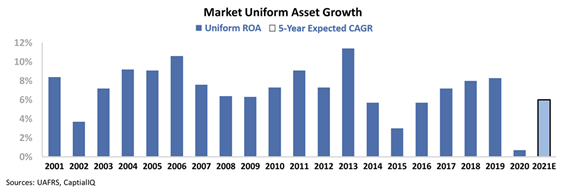How we can gain insight about asset growth based on earnings calls

Sentiment is so important to understand. It comes in many shapes and sizes, and today, we will look at it from management’s point of view.
Today, we will evaluate what management has said on recent earnings calls and what that could mean for asset growth this year.
Investor Essentials Daily:
The Monday Macro Report
Powered by Valens Research
In the short-term, the market is a voting machine. That’s why we talk about investor sentiment so often during our Monday macroeconomic insights. Specifically, for investor sentiment, we regularly talk about correlations, active investor allocations, and even short interest levels.
These metrics are so important because human sentiment tends to flip quickly. That’s why the field of behavioral economics exists. Financial markets are just an aggregation of humans (and machines designed by humans), human nature naturally affects financial markets.
Collective investor sentiment can change in only a matter of weeks. Investors can go from bullish levels, to bearish levels, to back to bullish again.
So, when everyone gets bullish, it may be a sign to sell. When investors start to get worried, like in March 2020, it may be time to buy.
We call this a contrarian indicator.
However, as this Bloomberg article highlights, the last few months have made it difficult to be a contrarian.
Throughout most of the pandemic, nearly all investor sentiment indicators have been positive. Right now, investor expectations are incredibly bullish. Investors expect the market to be higher, gross domestic product (GDP) to rise, and unemployment to decrease.
The market is also bullish on global earnings and believes high-yield debt will outperform investment grade debt.
Normally, all these positive signals might indicate the market is overheating and needs a sell-off. This could be especially true as the calendar has just turned. Considering how strong the rally was in November and December, it would be reasonable to be concerned that the market has pulled potential profits for this year, into 2020.
However, there’s a reason that we don’t just look at investor sentiment signals. It’s not a complete picture. As we often mention, we need to look at the data as a mosaic to understand the market’s valuation.
For example, earnings growth is currently a bullish indicator. Earnings are what drive the market at the end of the day, and they are primed to accelerate. This could create significant upside potential.
To get insight into the probability of earnings expansion, we can look at management sentiment. While investor sentiment is important, management sentiment may be even more insightful. These are the people driving the companies and they know them better than anyone.
To gain an understanding of manager sentiment, we can use our aggregate management growth confidence index. This is based on our Earnings Call Forensics™ (ECF) technology.
Our ECF data show us when management teams are “highly questionable,” “questionable,” “highly confident,” and “excited.”
Highly questionable (“HQ”) markers signal management may be holding back significantly on communicating what they’re really thinking about a subject. Questionable (“Q”) markers indicate a lower degree of management withholding their true feelings.
Meanwhile, highly confident (“HC”) markers signal if executives have conviction in what they’re talking about. Excited (“EXC”) markers, which are exceedingly rare, highlight giddiness from management on a subject.
Aggregating our ECF data for the companies we run across the market allows us to identify trends in management conviction and excitement. In turn, this tells us when management is confident about growth opportunities.
After a dip in April and May, the aggregate growth confidence index recovered and has held steady at better-than-average levels. Even with concerns about the pandemic, election, and stimulus, the index stayed near or above averages.
Management teams see the current environment as a growth opportunity. They are ready to invest in capital expenditures (capex) and research & development to grow their business in this economy.
Meanwhile, the market does not have the same aggressive expectations for growth. Due to the pandemic, companies did not have many opportunities to grow their business in 2020, leading to Uniform Asset growth being only 1%.
With management showing significant confidence and vaccine distribution potentially starting to alleviate the pandemic overhang later this year, capex spending looks bullish for 2021 and beyond. Despite this, the market is only pricing in 6% Uniform Asset growth. This would be below averages over the past two decades.
This conservative forecasting could be a sign for continued investor bullishness. If companies grow at closer to 8%, as they did in 2018 and 2019, markets may be in for a positive surprise.
It is understandable for investors to not be excited about 2021. The market was able to eke out a 16% gain in 2020 even with grave economic uncertainty, and that looks hard to reproduce on first blush. However, looking at bullish management and low expectations, there may be room to grow.
Best regards,
Joel Litman & Rob Spivey
Chief Investment Strategist &
Director of Research
at Valens Research






